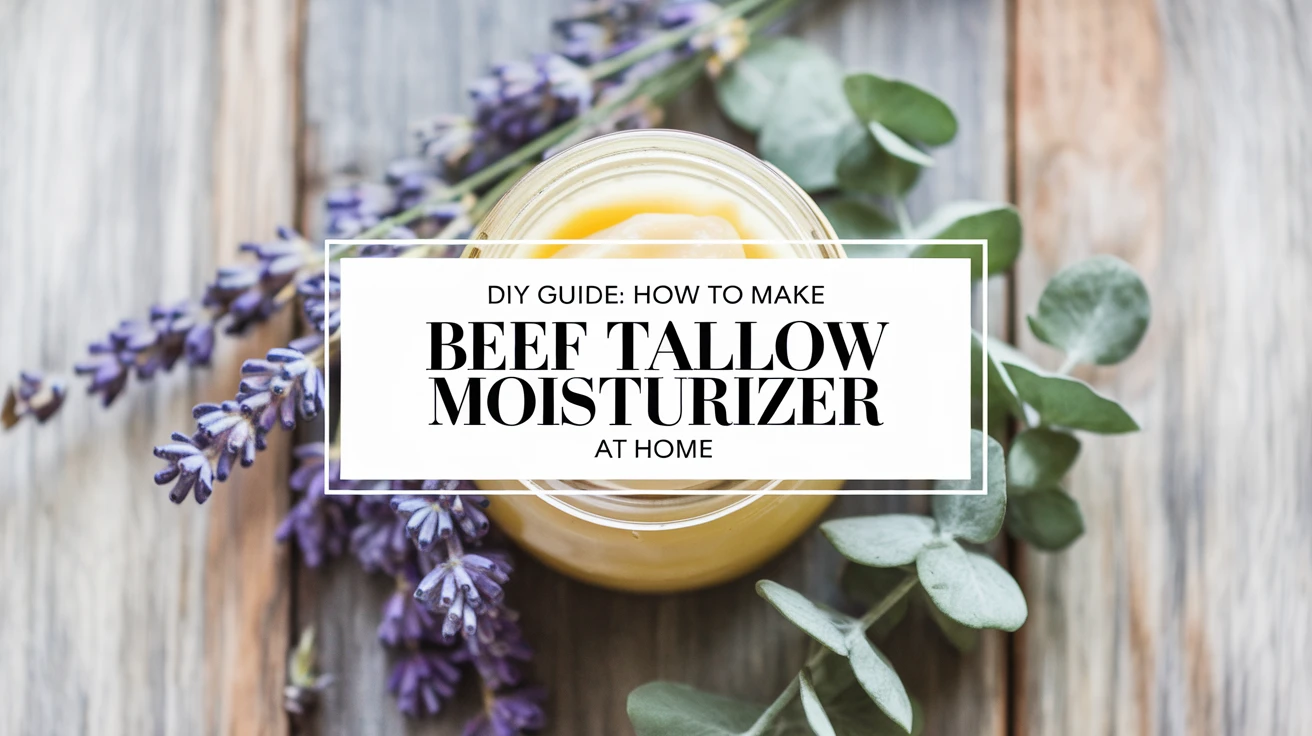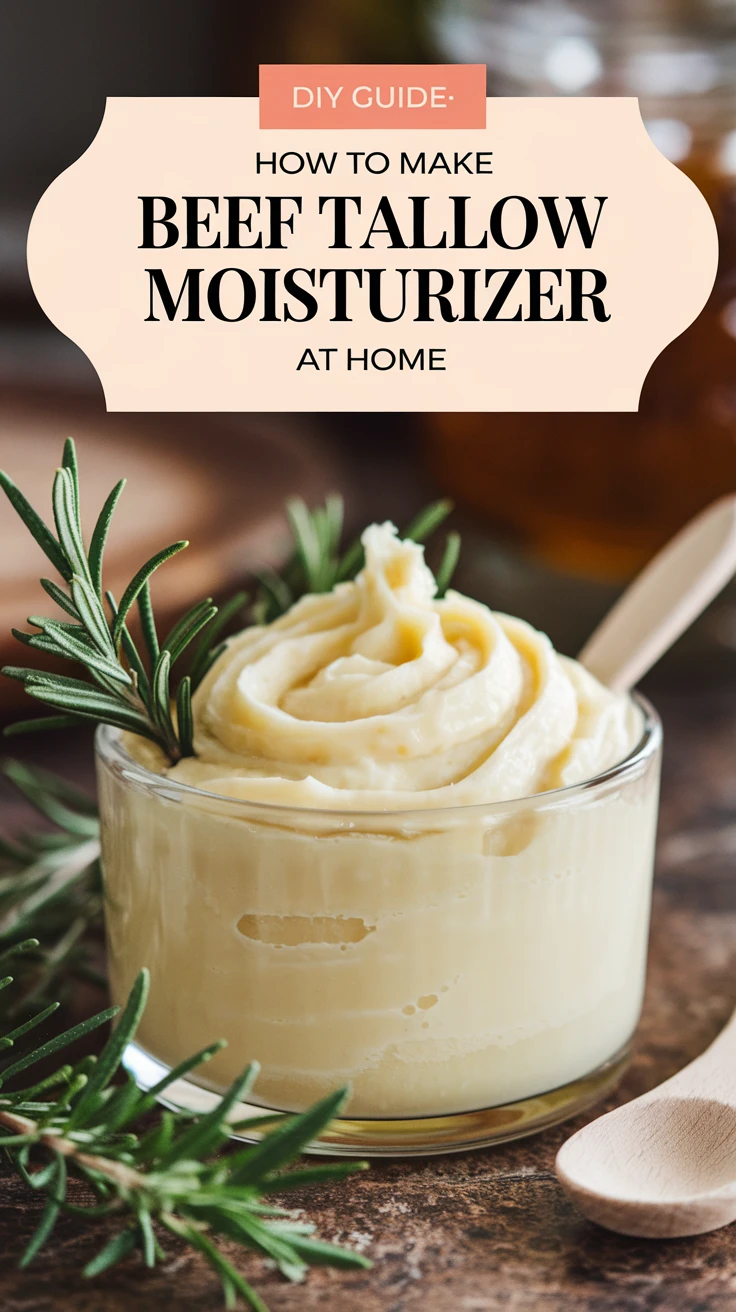
Introduction to Beef Tallow Moisturizer
Learning how to make beef tallow moisturizer has been a game-changing discovery in my natural skincare journey. As someone who struggled with finding the perfect moisturizer for years, discovering this ancestral beauty secret transformed my skincare routine completely. This comprehensive guide will walk you through creating your own nourishing tallow-based moisturizer that rivals expensive commercial products.
Before we dive into the process, let’s understand why tallow has become increasingly popular in natural skincare:
- Highly compatible with human skin cell structure
- Rich in vitamins A, D, E, and K
- Contains conjugated linoleic acid (CLA)
- Deeply moisturizing without being greasy
- Sustainable and economical
What is Beef Tallow and Its Benefits for Skin
Beef tallow is rendered fat from cattle, specifically the fat that surrounds the kidneys and other organs. This nutrient-dense substance has been used for centuries in skincare, and for good reason. Its molecular structure closely resembles our skin’s natural oils, making it exceptionally effective for moisturizing.
Key Nutritional Components
- Saturated fats that protect and nourish skin barrier
- Fat-soluble vitamins essential for skin health
- Natural antimicrobial properties
- Anti-inflammatory compounds
- Omega-3 and omega-6 fatty acids
Pro tip: Always source your tallow from grass-fed, organic beef for the highest nutrient content and best results.
Required Materials and Ingredients
Before learning how to make beef tallow moisturizer, gather all necessary supplies. Here’s what you’ll need:
| Basic Ingredients | Quantity |
|---|---|
| Rendered beef tallow | 1 cup |
| Organic olive oil or jojoba oil | ¼ cup |
| Essential oils (optional) | 15-20 drops |
Equipment Needed
- Double boiler or heat-safe bowl and pot
- Glass storage containers
- Thermometer (optional)
- Mixing spoon or whisk
- Fine mesh strainer
- Clean cloth for straining (optional)
Pro tip: Sterilize all equipment before starting to ensure your moisturizer remains free from contamination.
Step-by-Step Process: How to Make Beef Tallow Moisturizer
Following these detailed steps will ensure your tallow moisturizer turns out perfect every time:
- Prepare the Tallow:
- If using raw tallow, render it first
- Strain rendered tallow through a fine mesh
- Allow to cool slightly but remain liquid
- Create the Base:
- Set up your double boiler
- Melt tallow gently (around 130°F)
- Add carrier oil slowly while stirring
- Add Optional Ingredients:
- Let mixture cool to 120°F
- Add essential oils if desired
- Stir thoroughly to combine
- Pour and Set:
- Transfer to storage containers
- Let cool completely at room temperature
- Seal containers tightly
Pro tip: For a smoother texture, whip the mixture with a hand mixer as it cools.
Storage and Usage Tips
Proper storage is crucial for maintaining the quality of your homemade beef tallow moisturizer. Here’s how to keep it fresh:
- Store in dark glass containers
- Keep away from direct sunlight
- Use within 6 months
- Store in a cool, dry place
- Consider refrigeration in warm climates
Pro tip: Make smaller batches initially until you determine your ideal usage rate.
Customization Options
One of the best aspects of making your own tallow moisturizer is the ability to customize it. Here are some popular variations:
| Essential Oil Blend | Benefits |
|---|---|
| Lavender + Frankincense | Calming, anti-aging |
| Tea Tree + Eucalyptus | Antibacterial, clarifying |
| Rose + Geranium | Balancing, hydrating |
Pro tip: Start with a small amount of essential oils and adjust according to preference.
Troubleshooting Common Issues
Even experienced makers can encounter challenges. Here are solutions to common problems:
- Grainy texture: Reheat and cool more slowly
- Too hard: Increase carrier oil ratio
- Too soft: Add more tallow
- Unpleasant smell: Use higher quality tallow or adjust essential oils
- Separation: Mix more thoroughly during cooling
Pro tip: Document your process and adjustments to replicate successful batches.
Benefits of Using Tallow Moisturizer
After months of personal use and research, here are the key benefits I’ve observed:
- Deep, lasting hydration
- Improved skin barrier function
- Reduced appearance of fine lines
- Better absorption than commercial moisturizers
- Cost-effective skincare solution
- Minimal ingredients means less potential for reactions
Pro tip: Apply to slightly damp skin for enhanced absorption.
Conclusion
Learning how to make beef tallow moisturizer opens up a world of natural skincare possibilities. This traditional remedy has proven its worth through generations, and now you have the knowledge to create this nourishing moisturizer at home. Remember to source quality ingredients, maintain proper hygiene during preparation, and customize the recipe to suit your needs.
Frequently Asked Questions
How long does beef tallow moisturizer last?
When properly stored in a cool, dark place, tallow moisturizer typically lasts 6-12 months. Adding vitamin E oil can extend shelf life.
Can I use other animal fats instead of beef tallow?
While other animal fats can be used, beef tallow is preferred due to its similar composition to human skin oils and higher nutrient content.
Why is my tallow moisturizer grainy?
Graininess usually occurs from cooling too quickly. Reheat gently and allow to cool more slowly, stirring occasionally.
Is tallow moisturizer suitable for all skin types?
Yes, tallow moisturizer is generally suitable for all skin types, but those with specific sensitivities should patch test first.
Can I add other ingredients to the moisturizer?
Yes, you can add ingredients like shea butter, coconut oil, or vitamin E oil, but maintain the basic tallow-to-carrier oil ratio for stability.

